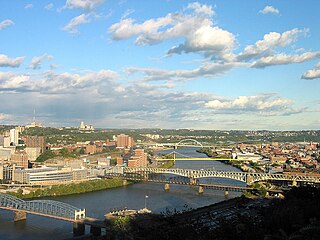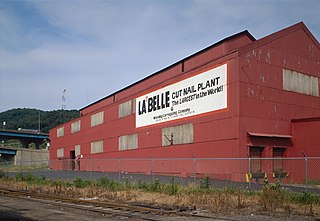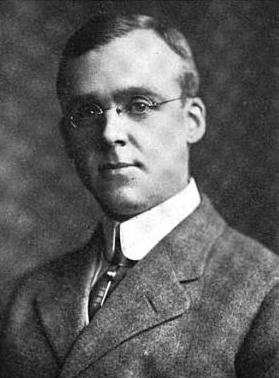Related Research Articles

Monongalia County, known locally as Mon County, is located in the U.S. state of West Virginia. As of the 2020 census, the population was 105,822, making it West Virginia's third-most populous county. Its county seat is at Morgantown. The county was founded in 1776. Monongalia County is included in the Morgantown, WV Metropolitan Statistical Area, and is the largest county in North-Central West Virginia. It is part of the Pittsburgh media market.
Despard is a census-designated place (CDP) in Harrison County, West Virginia, United States. The population was 1,004 at the 2010 census.

Morgantown is a city in and the county seat of Monongalia County, West Virginia, United States, situated along the Monongahela River. The largest city in North-Central West Virginia and the third-largest city in the state, Morgantown is best known as the home of West Virginia University. The population was 30,347 at the 2020 census. The city serves as the anchor of the Morgantown metropolitan area, which had a population of 138,176 in 2020.

Star City is a town in Monongalia County, West Virginia, United States. The population was 1,779 at the 2020 census. It is included in the Morgantown, West Virginia Metropolitan Statistical Area.

The Monongahela River, sometimes referred to locally as the Mon, is a 130-mile-long (210 km) river on the Allegheny Plateau in north-central West Virginia and Southwestern Pennsylvania. The river flows from the confluence of its west and east forks in north-central West Virginia northeasterly into southwestern Pennsylvania, then northerly to Pittsburgh and its confluence with the Allegheny River to form the Ohio River. The river includes a series of locks and dams that makes it navigable.

United States Steel Corporation, more commonly known as U.S. Steel, is an American integrated steel producer headquartered in Pittsburgh, Pennsylvania, with production operations primarily in the United States of America and in Central Europe. The company produces and sells steel products, including flat-rolled and tubular products for customers in industries across automotive, construction, consumer, electrical, industrial equipment, distribution, and energy. Operations also include iron ore and coke production facilities.

The economy of West Virginia nominally would be the 62nd largest economy globally behind China, Iraq and ahead of Croatia according to 2009 World Bank projections, and the 64th largest behind Iraq and ahead of Libya according to 2009 International Monetary Fund projections. The state has a projected nominal GDP of $63.34 billion in 2009 according to the Bureau of Economic Analysis report of November 2010, and a real GDP of $55.04 billion. The real GDP growth of the state in 2009 of .7% was the 7th best in the country. West Virginia's economy accelerated in 2014 with a growth rate of 5.1%, ranking third among the fastest growing states in the United States alongside Wyoming and just behind North Dakota and Texas. In 2021, the state GDP was $72.48 billion, an increase over $69.71 billion in 2021.
Wheeling-Pittsburgh Steel was a steel manufacturer based in Wheeling, West Virginia.

Homestead Steel Works was a large steel works located on the Monongahela River at Homestead, Pennsylvania in the United States. The company developed in the nineteenth century as an extensive plant served by tributary coal and iron fields, a railway 425 miles (684 km) long, and a line of lake steamships. The works was also the site of one of the more serious labor disputes in U.S. history, which became known as the Homestead strike of 1892.
The U.S. Steel recognition strike of 1901 was an attempt by the Amalgamated Association of Iron, Steel and Tin Workers to reverse its declining fortunes and organize large numbers of new members. The strike failed.

Amalgamated Association of Iron and Steel Workers (AA) was an American labor union formed in 1876 to represent iron and steel workers. It partnered with the Steel Workers Organizing Committee of the CIO, in November 1935. Both organizations disbanded May 22, 1942, to form a new organization, the United Steelworkers.
Before 1800 A.D., the iron and steel industry was located where raw material, power supply and running water were easily available. After 1950, the iron and steel industry began to be located on large areas of flat land near sea ports. The history of the modern steel industry began in the late 1850s. Since then, steel has become a staple of the world's industrial economy. This article is intended only to address the business, economic and social dimensions of the industry, since the bulk production of steel began as a result of Henry Bessemer's development of the Bessemer converter, in 1857. Previously, steel was very expensive to produce, and was only used in small, expensive items, such as knives, swords and armor.

The Tennessee Coal, Iron and Railroad Company (1852–1952), also known as TCI and the Tennessee Company, was a major American steel manufacturer with interests in coal and iron ore mining and railroad operations. Originally based entirely within Tennessee, it relocated most of its business to Alabama in the late nineteenth century, following protests over its use of free convict labor. With a sizable real estate portfolio, the company owned several Birmingham satellite towns, including Ensley, Fairfield, Docena, Edgewater and Bayview. It also established a coal mining camp it sold to U.S. Steel which developed it into the Westfield, Alabama planned community.

James Davis Gronninger was an American attorney, baseball player, manager, and league president.

The Downtown Morgantown Historic District is a federally designated historic district in Morgantown, Monongalia County, West Virginia. The district, encompassing approximately 75 acres, has 122 contributing buildings and 2 contributing sites including commercial and public buildings, residences, and churches. The district has been listed on the National Register of Historic Places since May 2, 1996. Ten of the contributing buildings are listed separately on the National Register of Historic Places. Significant structures located within the historic district are the Monongalia County Courthouse, the Metropolitan Theater, and the Old Morgantown Post Office.

La Belle Iron Works, also known as La Belle Cut Nail Works, was a historic factory complex and national historic district located at Wheeling, Ohio County, West Virginia. The district included four contributing buildings; three Italianate style brick buildings dated to the founding of the company in 1852, and a tin plate mill built 1894–1897. After 1902, the buildings were combined under a single roof, although the truss systems date to different periods achieving the configuration visible today. When listed in 1997, it was known as the "La Belle Cut Nail Plant, The Largest in the World, Wheeling Corrugating Company, A Division of Wheeling Pittsburgh Steel Corporation." The cut nail machinery still in use by La Belle dated to 1852 and the 1860s. The machinery at La Belle along with the different processes were documented by the Historic American Buildings Survey team during the summer of 1990.
The Morgantown and Kingwood Railroad was a railroad in West Virginia in the United States. It extended from the Baltimore and Ohio Railroad (B&O) junction in Morgantown in Monongalia County via Masontown, Kingwood and Rowlesburg to the M&K junction with the B&O in Preston County, a distance of 47.9 mi (77.1 km). The M&K also operated approximately 5 mi (8.0 km) of branch lines along the route.

Ernest Tener Weir was an American steel manufacturer best known for having founded both Weirton Steel and the town of Weirton, West Virginia.
Sterling Plumbing is the brand-name of a line of plumbing products manufactured by Kohler Co. The company designs and manufactures a diverse selection of product for the bath, including whirlpool tubs, sinks, toilets, shower doors and bathroom accessories.
The Columbia Steel Company was organized in 1909 with main offices at 503 Market Street, San Francisco. When formed the company had one plant in Portland, Oregon established in 1903 and a bigger plant in Pittsburg, California established in 1909-1910. The company's namesake is the Columbia River. In 1917 the Pittsburg plant had a monthly output of 800 tons open hearth steel and employed 375.
References
- 1 2 3 Decision, American Sheet & Tin Plate Co. et al (FTC Docket No. 2741) (PDF), vol. 22, U.S. Federal Trade Commission, June 24, 1936, retrieved 2021-07-22
- ↑ "U.S. Steel Photograph Collection - American Sheet and Tin Plate Co., Looking West Toward Tin Plate Plant from #2 Scrap Yard Structure". U.S. Steel Gary Works Photograph Collection, 1906-1971. Indiana University . Retrieved 2013-11-28.
- ↑ "Steel Trust Proposes to Cut Pay of Employees". Baltimore, Maryland: The Baltimore Sun. 12 November 1903. p. 1.
- ↑ "Political and General". The Pantagraph. Bloomington, Illinois. 1 January 1904. p. 4.
- ↑ "Tin Plante Plants Closed". The Wall Street Journal. New York, New York. 18 April 1906. p. 8.
- ↑ "Papers Past — Evening Post — 11 November 1919 — LABOUR UNREST". The Evening Post (New Zealand) . PapersPast. 1919-11-11. Retrieved 2013-11-28.
- ↑ "United States v. American Sheet & Tin Plate Co. - 301 U.S. 402 (1937)". Justia US Supreme Court Center. 1937-05-17. Retrieved 2013-11-28.
- ↑ The Monongalia County Courthouse, County Clerks Office, Deed Books 67 & 71, p. 318 & 11.
- ↑ The Monongalia County Courthouse, County Clerks Office, Deed Book 84, p. 236-241.
- 1 2 Core, Earl L. (1984). The Monongalia Story: A Bicentennial History Vol. V. Parsons, West Virginia: McClain Printing Company. pp. 69 & 75. ISBN 0-87012-465-X.
- ↑ The Pittsburgh Post, Pittsburgh, PA, July 20, 1909
- ↑ The Buffalo Enquirer, Buffalo, NY, September 23, 1908 & The Daily Telegram, Clarksburg, WV, January 25, 1913.
- ↑ Callahan Jr., James Morton (1953). Morgantown, 1925-1950 An Economic and Social Study. Morgantown, West Virginia: West Virginia University. p. 58.